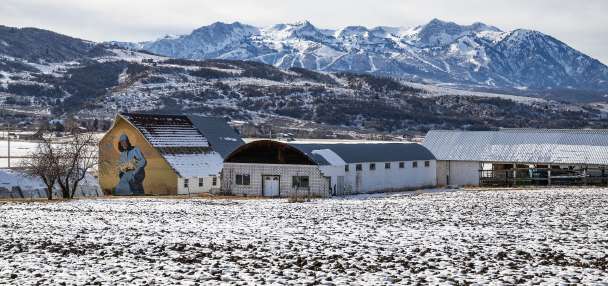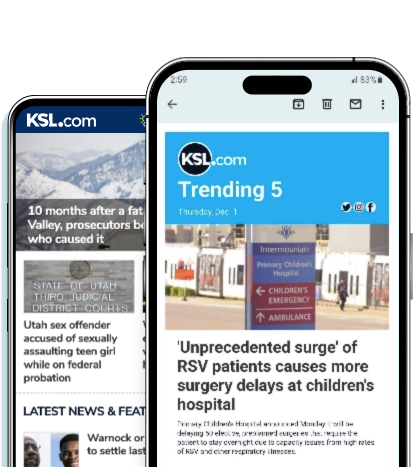Estimated read time: 5-6 minutes
This archived news story is available only for your personal, non-commercial use. Information in the story may be outdated or superseded by additional information. Reading or replaying the story in its archived form does not constitute a republication of the story.
SALT LAKE CITY — As the summer nears, the number of people recreating outside is on the rise — and so is the threat of fires on public lands.
That's especially true this year due to the state and region's ongoing severe drought situation. In fact, during his monthly PBS Utah news briefing Thursday, Gov. Spencer Cox warned about the drought's potential to carry over into the wildfire season.
"Let me just state unequivocally, guys, it's really bad. It's as bad as it's been," Cox said of the dry conditions in Utah. "We need everyone to understand right now that we're heading into one of the worst droughts and potentially worst fire seasons that we've seen, and we've seen some bad ones. … How bad it gets really depends on the weather. That's out of our control."
About 90% of the state remains in an "exceptional" drought, and all parts of the state are experiencing drought conditions even after some recent rain storms, according to the U.S. Drought Monitor. The summer months of June, July and August are also traditionally the driest months at least in northern Utah.
Cox issued a state of emergency due to the drought conditions on March 17. It's an order that the Utah Legislature extended Wednesday during a special legislative session. The drought has consequences for all aspects of Utah life, but it's also a factor in the Great Basin Coordination Center's fire season outlook maps.
It's worth noting that Utah wasn't listed in above-normal fire threats by the agency until the start of May, which is when central Utah fell into that category. Almost all of central and northern Utah are expected to have above-normal fire threats by June and July. That's on top of the numerous red flag warnings for conditions conducive for fires that have been issued across southern and eastern Utah this year.
Meanwhile, there had already been 232 wildfires in Utah this year as of Thursday morning, according to the Utah Wildfire Dashboard, which is a joint venture between the Bureau of Land Management and Utah Division of Forestry, Fires and State Lands. The fires so far have been relatively small, averaging about 36 acres burned per fire to this point.
The more troubling statistic is that at least 95% of this year's fires were determined to be human-caused. Human-caused fires have been tied to all but three acres of the 8,399 total acres burned during the 2021 fire season, according to the dashboard.
The number of fires Utah has already had this year exceeds the normal tally heading into the end of May and the start of summer, according to state land officials.
Cox urged Utahns to check fire restrictions before beginning any open burning, ensure any chains that might be attached to their vehicles aren't dragging, and that people who go out target shooting do so in areas where that's allowed. Those are a few of the many ways a human-caused fire can ignite.
"We need everybody to be especially cautious," he said.
New BLM fire order in place adds to a growing list in Utah
Given all of the fire outlook and fires that already occurred this year, efforts have started early to ban certain activities on public lands that can spark wildfires. For example, Cox spoke about the issue a day after the Bureau of Land Management announced a new statewide fire prevention order that went into effect immediately.
The order bans the use or discharge of explosive material or exploding targets, fireworks, or steel component ammunition on any land managed by the bureau. About 42% of the state falls within the category of BLM-managed land.
"This annual fire prevention order reminds people to be fire-wise to reduce the number of human-caused wildfires, especially considering the extreme drought this year," said Greg Sheehan, BLM's Utah state director, in a statement.
The order states that anyone who violates it can be fined up to $1,000 and face up to one year in jail, as well as a steep bill for the cost of fire suppression should their actions lead to a wildfire.
It's also the latest order on top of a growing list issued for Utah public lands this year.
Utah State Fire Management Officer Brett Ostler signed a proclamation moving up the "closed fire season" for counties in southwest Utah from June 1 to May 1. That limited the use of open burning on unincorporated state and private lands in Beaver, Garfield, Iron, Kane and Washington counties a month sooner than usual, unless given the proper permit.
Navajo Nation President Jonathan Nez this week also issued an executive order that banned building fires or campfires outside of developed fire rings or grills and fireworks or firearms/incendiary devices without a valid permit on Navajo Nation land, which includes parts of San Juan County.
Fireworks are currently banned in the state, but there is a brief window where they can be sold and launched in the summertime. Cox said Thursday he would work "closely" with the state Legislature to discuss any possible new fireworks restrictions ahead of the Independence Day and Pioneer Day periods in July where fireworks can be sold and launched in the state.
"It really depends on what the rain situation looks like leading up to fireworks season," the governor said.









